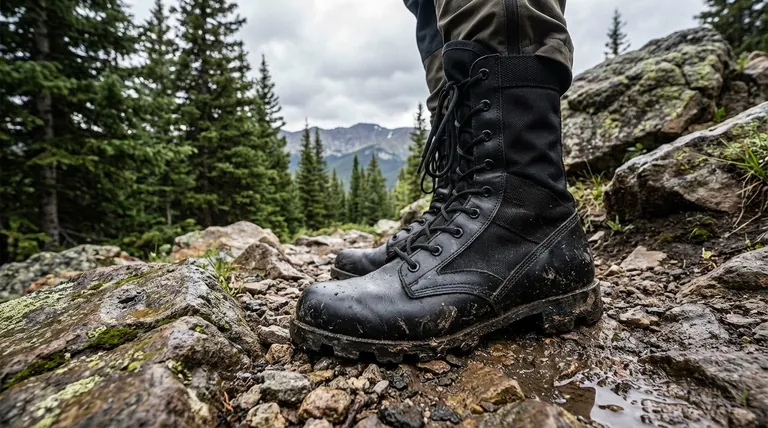For certain types of hiking, military boots offer significant advantages stemming from their core design philosophy. They are built for extreme durability, superior ankle support on uneven ground, reliable water resistance, and aggressive traction, making them a formidable option for challenging and rugged conditions.
While military boots provide exceptional durability and ankle support for rugged terrain, this protection comes at the cost of weight and comfort. This makes specialized hiking boots a better choice for most long-distance or high-mileage journeys.

The Core Strengths of Military Boots on the Trail
Military boots are engineered for survival and performance in harsh environments. These design priorities translate into specific benefits when used for hiking.
Unmatched Durability
Military boots are constructed from high-quality materials like full-grain leather and heavy-duty synthetic fabrics. This focus on wear resistance means they can withstand sharp rocks, thick brush, and abrasive terrain far better than many lighter boots.
Superior Ankle Support
The high-cut design of most military boots is a key feature. This provides exceptional ankle stabilization, which is critical for preventing sprains and twists when navigating treacherous, uneven, or unstable ground.
Reliable Water Resistance
Designed for use in all conditions, these boots typically offer excellent performance in wet environments. Their materials and construction help keep your feet dry when crossing streams or hiking through mud and rain.
Aggressive Traction
The outsoles on military boots feature deep, rugged lugs. This design provides a confident grip across a wide variety of surfaces, from loose dirt and slippery mud to rocky inclines.
Understanding the Trade-offs
The very features that make military boots so tough also create significant disadvantages compared to modern, specialized hiking footwear. Acknowledging these trade-offs is crucial.
The Burden of Weight
Durability comes from heavy materials. Military boots are almost always heavier than hiking boots, and this extra weight can lead to significant fatigue over long distances, requiring more energy with every step.
The Mandatory Break-in Period
Their stiff, robust construction means military boots require a mandatory break-in period. If you take them on a long hike straight out of the box, the stiff leather can cause painful blisters and hot spots. You must wear them gradually for short periods to soften the materials.
The Breathability Problem
The same features that provide excellent water resistance often trap heat and moisture. In hot or dry climates, this lack of breathability can lead to excessively sweaty feet, which is not only uncomfortable but can also contribute to blisters.
The Issue of Stiffness
While stiffness aids in support, it can reduce overall comfort on a long trek. Modern hiking boots are engineered with a specific flex that aids the natural motion of your foot, a feature often lacking in the more rigid design of a military boot.
Making the Right Choice for Your Goal
The decision to use military boots should be based entirely on your specific hiking objective and environment.
- If your primary focus is maximum protection on rugged, off-trail terrain: The durability and ankle support of military boots make them a viable choice for this specific use case.
- If your primary focus is comfort on long-distance treks: A dedicated, lightweight hiking boot is almost always the superior option to prevent fatigue and discomfort.
- If your primary focus is versatility across different climates and trails: A specialized hiking boot offers a far better balance of weight, breathability, support, and comfort.
Ultimately, choosing the right footwear is about matching the tool to the specific demands of your journey.
Summary Table:
| Feature | Military Boots | Specialized Hiking Boots |
|---|---|---|
| Best For | Rugged, off-trail terrain | Long-distance, high-mileage treks |
| Durability | Excellent (Full-grain leather, heavy-duty) | Good (Lightweight, technical materials) |
| Ankle Support | Superior (High-cut design) | Good to Excellent (Varied designs) |
| Weight | Heavy | Light to Moderate |
| Break-in Period | Mandatory and lengthy | Minimal to none |
| Breathability | Lower (Focus on water resistance) | Higher (Focus on comfort) |
Need durable, high-performance footwear for demanding conditions?
As a large-scale manufacturer, 3515 produces a comprehensive range of footwear for distributors, brand owners, and bulk clients. Our production capabilities encompass all types of rugged shoes and boots, built to meet the highest standards of durability and support.
Let us help you equip your customers with the right footwear for their adventures. Contact our team today to discuss your manufacturing needs.
Visual Guide

Related Products
- Durable Military Combat Boots with Water Drainage for Wholesale & OEM
- Wholesale Waterproof Tactical Boots Custom Suede & High-Traction Soles
- Durable Leather Tactical Boots Wholesale & Custom Manufacturing for Brands
- Wholesale Lightweight Tactical Boots with Dial Closure OEM & Bulk Orders
- Durable Leather High-Ankle Tactical Boots for Wholesale & Custom Manufacturing
People Also Ask
- How did combat boots transition from military use to popular culture? From Battlefield to Fashion Statement
- What are the limitations of combat boots? Understanding the Trade-offs of Rugged Footwear
- What has been the global recognition of fabric for over 30 years? Industry's Trusted Benchmark for Durability
- How can a shiny finish be achieved on military boots? A Step-by-Step Guide to a Mirror Shine
- What are the key features of the new Army Jungle Combat Boot? A Breakdown for Hot & Wet Environments



















